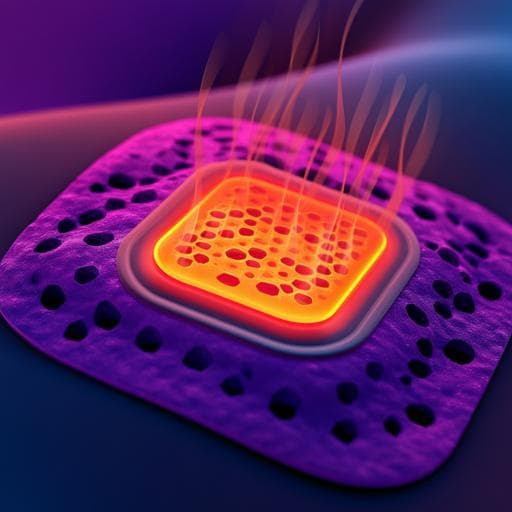
Engineering and Technology
A high performance wearable strain sensor with advanced thermal management for motion monitoring
C. Tan, Z. Dong, et al.
Discover the groundbreaking advancements in wearable strain sensors reported by authors Cenxiao Tan, Zhigang Dong, Yehua Li, Haiguang Zhao, Xingyi Huang, Zhaocai Zhou, Jin-Wu Jiang, Yun-Ze Long, Pingkai Jiang, Tong-Yi Zhang, and Bin Sun. This innovative sensor not only excels in motion monitoring but also enhances thermal management, achieving a remarkable 32% reduction in saturated temperature—a game-changer for future applications!
~3 min • Beginner • English
Introduction
The study addresses a critical challenge in stretchable resistive strain sensors: operational heat generated by resistance changes and nanocontact resistance during deformation can compromise device performance, safety, and reliability. Traditional encapsulants (e.g., PDMS, epoxy) are electrically insulating but thermally poor, hindering heat dissipation, while wearable applications must also maintain skin thermal comfort (30–34 °C) and avoid heat accumulation at the skin-sensor interface. The authors aim to develop a highly stretchable, sensitive, and durable strain sensor with advanced thermal management that simultaneously enhances heat dissipation from the device while thermally insulating the skin. They leverage a thermally conductive, electrically insulating TPU matrix filled with boron nitride nanosheets (BNNSs) to dissipate heat to the environment and a porous electrospun TPU fibrous membrane that provides thermal insulation and breathability for skin comfort. The hypothesis is that combining a surface GNR conductive network with a TPU-BNNS thermal pathway and a porous TPU insulating layer will yield high-performance sensing with effective thermal control under static and dynamic strains.
Literature Review
Wearable stretchable strain sensors (resistive, capacitive, piezoelectric, triboelectric) have been widely studied for soft robotics, HMI, and health monitoring. Carbon nanomaterials (graphene, CNTs) have enabled high-sensitivity resistive sensors due to their flexibility and conductivity. However, large nanocontact resistance variations produce significant Joule heating; while exploited for nanoheaters, such heat is detrimental in stretchable electronics. Prior thermal management approaches include conductive polymer composites (metal, carbon, ceramic fillers) but often risk electrical exposure; encapsulation with electrical insulators is necessary yet commonly thermally resistive. BN nanosheets are promising thermally conductive and electrically insulating fillers; low loadings can boost thermal conductivity without degrading elastomer mechanics, and prior work showed electrospun-fiber-enabled BNNS orientation and overlap can enhance thermal dissipation. Conversely, electrospun fibrous membranes’ high porosity and tunable pores enable thermal insulation and breathability. Despite progress in each domain, few works address heat dissipation in stretchable electronics, and high-performance wearable sensors with integrated thermal management had not been reported.
Methodology
Materials and structure: The sensor comprises three layers: (i) electrospun TPU fibrous membrane, (ii) a surface-deposited graphene nanoribbon (GNR) conductive nanonetwork, and (iii) a cast TPU-BNNS film. GNRs (quasi-1D, ~150 nm width, ~4 µm length, ~3 nm thickness) are vacuum-filtered onto the electrospun TPU mat, forming a percolated surface network. BNNSs (1–2 µm lateral size, ~3 nm thickness) are dispersed and cast with TPU to form a dense film with well-overlapped BNNSs to create thermal pathways. Assembly sandwiches the GNR-coated fibrous membrane onto the damp-dry TPU-BNNS film (GNR side facing film), followed by drying and attaching Cu foil electrodes at the exposed fibrous ends. The integrated two-layer composite thickness is ~530 µm (electrospun ~345 µm + TPU-BNNS ~185 µm). BNNS loadings in films: 25, 30, 35 wt%. GNR areal loadings: 25, 50, 75 µg cm−2.
Fabrication details: Electrospun TPU fibers prepared under typical electrospinning conditions (solution in DMF/THF, ~12 kV, ~12 cm tip-to-collector distance, 2 h spinning at 20–50% RH). BNNS dispersed in DMF/THF (1:1), ultrasonicated 1 h, stirred 2 h; TPU added to 20 wt% and stirred 5 h; gel-like mixture doctor-bladed on glass to cast films. GNRs in DI water vacuum-filtered through as-spun TPU membrane; dried at 80 °C. When TPU-BNNS film was damp-dry, a 1 × 2 cm piece was overlaid with GNR-coated fibrous mat; dried at 70 °C for 12 h and peeled. Electrodes: Cu foils attached on naked ends of the fibrous mat to complete the sensor.
Mechanical and electromechanical testing: I–V curves measured from 0% to 160% static strain; dynamic cycling at fixed 100% strain across strain rates (1–8 mm s−1). Relative resistance change ΔR/R0 recorded under varying strain amplitudes (10–100%). Gauge factor GF = ΔR/(R0ε) computed for low (<60%) and high (>60%) strain regimes. Long-term cyclic durability tested for >5000 cycles between 0 and 100% strain. SEM observed GNR morphology during stretching.
Thermal characterization: Thermal conductivity K determined via laser flash method: K = ρ × Cp × D (through-plane), where density ρ (water displacement), specific heat Cp, and thermal diffusivity D measured (LFA 467). Samples: pure TPU film, TPU-BNNS films (25–35 wt% BNNS), electrospun TPU mats, GNR-TPU mats (50 µg cm−2), and full sensors (with 50 µg cm−2 GNRs and varying BNNS loadings). Thermal cycling stability of K assessed over 20 cycles between 25 and 125 °C. IR thermography captured surface temperatures under applied voltage (30 V) to evaluate saturated temperatures and dynamic thermal stability during repeated stretching (0–100% strain, >30 cycles). Interfacial thermal conductance G between TPU-BNNS surface and air modeled at steady state using heat-flux continuity: Qe = K(TH − T1)/h = G(T1 − Ta); parameters: h = 185 µm, K (measured), TH = 38.6 °C (GNR on TPU without encapsulation), T1 = 25.3 °C (sensor surface), Ta = 23 °C; G computed from measured Qe via temperature data.
Breathability: Gas permeability assessed by covering the electrospun side of the sensor over a water-filled graduated cylinder (blue ink added), weighted, in a vacuum oven at room temperature and 35% RH for 7 days; water loss compared to a standalone TPU-BNNS cast film.
Biocompatibility: Cytotoxicity via CellTiter-Lumi Plus assay. Extracts prepared by incubating strain sensor, TPU fibers, GNRs, and BNNSs in DMEM for 3 days. 293FT and GES1 cells seeded in 96-well plates (4×10^3 cells/well) with corresponding extracts; luminescence measured after lysis. Cell morphology assessed by immunofluorescence (α-Tubulin, DAPI) after 24 h exposure to extracts.
Human motion monitoring: Sensors mounted with surgical tape on knee and index finger for bending-relaxing detection; IR imaging showed thermal stability during movement. Elite dragon boat paddlers wore sensors on shoulder, wrist, and elbow; resistance signals recorded during standard vs nonstandard training to assess fatigue-related changes.
Key Findings
- Structure and materials: GNRs form a percolated surface network on electrospun TPU; BNNSs in TPU film overlap well, enabling thermal pathways. The assembled device is ~530 µm thick (fibrous ~345 µm; film ~185 µm).
- Mechanical/electrical performance: Sensor tolerates >300% tensile strain after assembly. I–V curves remain linear up to 160% strain with slope decreasing with strain. Optimal GNR loading is 50 µg cm−2 (25 µg cm−2 loses conductivity >60% strain; 75 µg cm−2 shows low sensitivity). ΔR/R0 scales with applied strain (10–100%) and is frequency-independent (1–8 mm s−1). Gauge factor GF ≈ 7.9 for ε < 60% and GF ≈ 35.7 for ε > 60%. Durable over >5000 cycles (0–100% strain) with stable signals and no delamination.
- Thermal conductivity: Through-plane K of TPU-BNNS films at 35 wt% is 1.37 W m−1 K−1, a 337% increase over pure TPU film (0.406 W m−1 K−1). Electrospun TPU and GNR-TPU mats have low K (0.0769 and 0.0949 W m−1 K−1), indicating thermal insulation. Full sensor K with 35 wt% BNNS and 50 µg cm−2 GNRs is 0.928 W m−1 K−1, a 2.42× enhancement over sensor without BNNS (0.383 W m−1 K−1). K remains stable over 20 thermal cycles between 25 and 125 °C.
- Temperature management: Under 30 V, saturated surface temperature decreases as BNNS loading increases; with 35 wt% BNNS and 50 µg cm−2 GNRs, saturated temperature is ~25.3 °C vs 37.2 °C for pure TPU cover, a 32% reduction. During >30 stretching cycles (0–100% strain), equilibrium surface temperature fluctuates within ~3.5 °C, indicating robust dynamic thermal stability.
- Interfacial thermal conductance: Simulated G between TPU-BNNS surface and air is 2.9 × 10^4 W m−2 K−1, indicating efficient heat transfer to the environment.
- Human motion sensing: Precise, repeatable resistance signals captured for knee and finger bending, including fine tremors. In dragon boat paddlers, shoulder-mounted sensors show two peaks per cycle (stretching and rotation); fatigue after 3 minutes reduces rotation peaks. Wrist-mounted sensors show increased multi-peak bending with fatigue; ΔR/R0 amplitudes decrease in nonstandard (fatigued) states at shoulder, wrist, and elbow.
- Breathability and biocompatibility: Electrospun-side gas permeability enables higher water vapor transmission than dense TPU-BNNS film over 7 days. Cytotoxicity assays show decreased viability for cells exposed to BNNS and GNR extracts, but extracts from the assembled strain sensor and TPU fibers show no significant cytotoxicity, indicating nanofillers are effectively immobilized within the composite.
Discussion
The integration of a thermally conductive, electrically insulating TPU-BNNS layer with a porous electrospun TPU membrane and a GNR conductive network addresses the dual challenges of heat generation and user safety in stretchable resistive sensors. BNNS networks within the TPU film provide overlapping contact areas that form continuous thermal pathways, significantly enhancing through-plane thermal conductivity and enabling rapid heat dissipation to ambient, as evidenced by reduced saturated temperatures and high interfacial thermal conductance to air. The porous electrospun TPU layer imparts thermal insulation toward the skin and breathability, mitigating heat accumulation at the skin-device interface and maintaining comfort.
Electromechanical tests show linear I–V behavior and high sensitivity over a wide strain range, with a transition to a higher GF at large strains due to separation of GNR contacts. The sensor demonstrates excellent durability and signal stability over thousands of cycles and maintains thermal equilibrium within a narrow range under repeated deformation, confirming reliable operation under realistic dynamic conditions.
Human motion monitoring validates precise detection of joint movements and discriminates standard vs fatigued paddling motions in athletes, illustrating applicability in sports training and rehabilitation. Biocompatibility tests indicate that while free nanofillers can be cytotoxic, their encapsulation in TPU matrices renders the device extracts non-toxic, supporting on-skin use.
Conclusion
This work presents a highly stretchable, sensitive, and durable wearable strain sensor that achieves advanced thermal management by combining a TPU-BNNS thermally conductive encapsulation with a porous electrospun TPU insulating substrate and a GNR conductive surface network. The device exhibits enhanced through-plane thermal conductivity (up to 0.928 W m−1 K−1 for the full sensor; 1.37 W m−1 K−1 for TPU-BNNS film), a 32% reduction in operational saturated temperature, stable dynamic thermal behavior under 0–100% strain cycling, and excellent sensing performance (GF up to 35.7, >5000-cycle durability). It reliably monitors human motion and distinguishes fatigue-related deviations in athletic training, while maintaining breathability and biocompatibility due to effective nanofiller immobilization.
These findings open opportunities for next-generation skin-attachable electronics where thermal stress is critical. Future work could explore optimizing BNNS orientation and loading to further raise thermal conductance without compromising mechanics, integrating wireless modules for continuous monitoring, long-term on-body studies under sweat and varied climates, and scaling fabrication for large-area, conformable arrays.
Limitations
- BNNS loadings were limited to 25–35 wt%; broader optimization (including alignment strategies) was not explored.
- The full sensor’s thermal conductivity, while enhanced, is reduced relative to the TPU-BNNS film due to the porous insulating layer; trade-offs between skin protection and device heat dissipation were not quantitatively optimized.
- Dynamic thermal stability was demonstrated for ~30 stretch cycles; longer-term thermal behavior under continuous operation and higher power densities was not reported.
- Cytotoxicity assessments were in vitro (293FT and GES1) using extracts; long-term in vivo on-skin evaluations, effects of sweat, and mechanical abrasion on filler exposure were not addressed.
- Human motion demonstrations involved small sample scenarios; systematic user studies with statistical analyses were not included.
Related Publications
Explore these studies to deepen your understanding of the subject.







